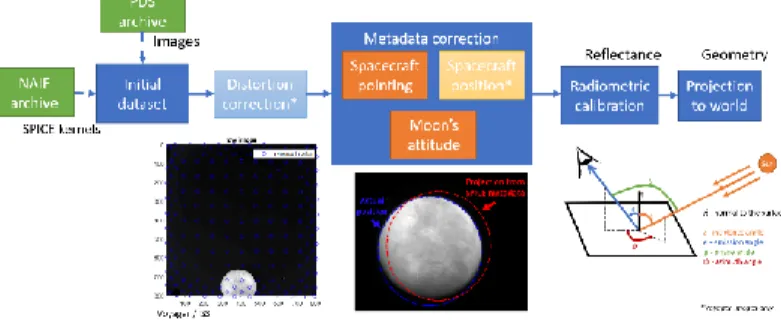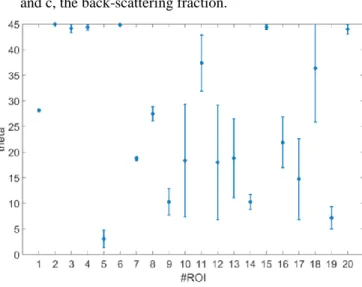HAL Id: hal-02902863
https://hal.archives-ouvertes.fr/hal-02902863
Submitted on 20 Jul 2020
HAL is a multi-disciplinary open access
archive for the deposit and dissemination of
sci-entific research documents, whether they are
pub-lished or not. The documents may come from
teaching and research institutions in France or
abroad, or from public or private research centers.
L’archive ouverte pluridisciplinaire HAL, est
destinée au dépôt et à la diffusion de documents
scientifiques de niveau recherche, publiés ou non,
émanant des établissements d’enseignement et de
recherche français ou étrangers, des laboratoires
publics ou privés.
A new look at Europa’s photometry in preparation of
the JUICE mission
Ines Belgacem, F. Schmidt, Grégory Jonniaux
To cite this version:
Ines Belgacem, F. Schmidt, Grégory Jonniaux. A new look at Europa’s photometry in preparation of
the JUICE mission. Lunar and Planetary Science Conference, Mar 2019, Houston, TX, United States.
�hal-02902863�
A NEW LOOK AT EUROPA’S PHOTOMETRY IN PREPARATION OF THE JUICE MISSION.
I. Belgacem1, F. Schmidt1 and Grégory Jonniaux2. 1GEOPS, Univ. Paris-Sud, CNRS, University Paris-Saclay, rue du
Belvédère, Bat. 504-509 Orsay, France., 2Airbus Defence & Space, Toulouse, France.
Contact: ines.belgacem@u-psud.fr
Introduction: Europa is a prime candidate for
hab-itability in our Solar System. The surface of the moon is the youngest of the Jovian icy satellites despite signs of erosion by space weathering and possible sublimation in the form of ice penitentes [1]. It seems to be continu-ously renewing by an expanding crust [2]. This activity appears to be driven by a global water ocean directly in contact with the rocky mantle [3]. This puts Europa and the other icy moons at the center of international space programs. The JUICE (JUpiter ICy moons Explorer) mission from the European Space Agency (ESA) is to be launched in 2022 and arrive at the Jovian system in 2030 to study Jupiter and its icy moons for three and a half years [4]. The spacecraft is being designed by Air-bus Defence & Space in Toulouse, France, with a very innovative navigation system. The vision-based naviga-tion algorithm implemented on JUICE will make the spacecraft more autonomous and more precise in its pointing by extracting navigation data from on-board image processing [5]. To offer the best of that algorithm, the spacecraft needs to have a proper knowledge of the photometric models of the moons targeted by the mis-sion.
Significant work has been done using the Voyager and telescopic observations [6, 7, 8, 9]. But none of these models give satisfying results when simulating images and comparing them to reality.
This work revisits the study of Europa’s photometry on restricted regions of interest using a new inversion approach to constrain Hapke’s model parameters.
Method: A photometric study necessitates two
pieces of information: reflectance and geometry. The first can be obtained after radiometric calibration. The second necessitates accurate projections of each pixel. Therefore, the first step of this work is image pro-cessing.
Dataset: This study uses images taken with the
Im-aging Science Subsystem (ISS) of the Voyager space-crafts and includes more recent images taken of Europa with the LOng Range Reconnaissance Imager (LORRI) of the New Horizons probe. Both datasets were re-trieved on NASA’s PDS archive [10, 11].
Correction of meta-data: We simulated images with
SurRender [12], an image renderer developed by Airbus DS allowing the input of custom reflectance models, and using meta-data obtained on NASA’s PDS. We compared those simulations to the real images and com-puted the correction in pointing needed to make them
match. The attitude of the moon was also refined by maximizing the correlation between simulations and real images. Additional corrections were needed on the Voyager images for which we also corrected for distor-tion and distance.
Figure 1: Entire pipeline to extract photometry from
images
Photometry: With accurate meta-data and after full
radiometric calibration of the images, we can success-fully project every pixel onto the moon and compute the observation geometry – incidence, emission and phase angle – for each of them as well as their physical reflec-tance value. We arbitrarily selected thirty-six regions of interest across Europa’s surface to study more closely.
Direct model: For this study we are considering
Hapke’s direct model [13]. Six parameters are to be es-timated: 𝑏, 𝑐, 𝜔, 𝜃̅, ℎ and 𝐵0.
Bayesian inversion: We have developed an
inver-sion tool using a Bayesian approach based on previous work done on Mars [14, 15, 16] and recent improve-ments [17]. No a priori knowledge of the parameters are inferred except for their physical domain of variation. A Monte Carlo Markov Chain algorithm is used to sample the Probability Density Function (PDF) of the a-poste-riori solution of each parameter which gives us not only information about the most probable value but also tells us how well the parameters are constrained on the dif-ferent ROIs.
Uncertainties: We modified the algorithm to
accom-modate a more complex covariance matrix considering both the noise in the image and the uncertainty on the absolute calibration of each image.
Results: We analyzed the results over twenty ROIs.
Figures 2 and 3 show the values for the macroscopic roughness 𝜃̅ and for the parameters of the particle
1416.pdf 50th Lunar and Planetary Science Conference 2019 (LPI Contrib. No. 2132)
scattering phase function - b, the asymmetry parameter and c, the back-scattering fraction.
Figure 2: Values of the macroscopic roughness 𝜃̅ over the different ROIs
𝜃̅ is well constrained for the majority of the ROIs and takes very different values from 2° to 45° although it mostly varies between 10° and 30°. It is the parameter that varies the most which makes sense since it is di-rectly linked to the terrain. It is also worth noting that half of the ROIs do not have a phase coverage extending beyond 40° where the photometric effects of 𝜃̅ are most significant [6, 18].
Figure 3: Values of the asymmetry parameter, b and
the backscattering fraction, c over the different ROIs (in blue) compared to the work of Domingue and
Hapke, 1992 [7] (in magenta)
The parameters b and c describe the shape of the diffu-sion lobe and correspond to the 2 parameters Heynyey-Greenstein’s phase function.
Their values can shed light on the microtexture of the particles at the surface [19]. The results of most ROIs are situated in the top-left corner of the diagram
indicating that we are rather dealing with rough, com-plex particles with high internal scattering. We note, however, that contrary to the results from Domingue and Hapke, 1992 [7] that we compare to ours in fig. 3, three ROIs are in the bottom-right corner of the dia-gram. These ROIs seem to be constituted of particles exhibiting a strong narrow forward scattering which would indicate smooth and clear particles in these areas.
Conclusion: This work is a new approach to the
photometric study of Europa using a Bayesian frame-work. The addition of Voyager images gives us a far broader phase coverage and makes it possible to look at more regions than our work focusing on LORRI images alone. We can infer surface properties on the different areas and compare that to studies of surface processes to help better understand the geological history of this satellite. In the interest of finding the best model to fit our data, we want to test more photometric models in the same framework. It is also crucial to find a model that works in more extreme observing geometries with emission and incidence angles up to 90°. Finally, the microtexture of Europa’s surface will be discussed with the recently proposed ice penitentes [1].
Acknowledgements: This work is supported by
Airbus Defence & Space, Toulouse (France) as well as the "IDI 2016" project funded by the IDEX Paris-Sac-lay, ANR-11-IDEX-0003-02.
References: [1] D. E. J. Hobley et al. (2018) Nature
Geosci., 11(12):901-904. [2] S. A. Kattenhorn and L.
M. Prockter (2014) Nature Geosci., 7:762–767. [3] R. T. Pappalardo, et al. (1999) JGR: Planets, 104 (E10) :24015_24055. [4] O. Grasset et al. (2013) Planet. and
Space Sci., 78:1-21. [5] G. Jonniaux and D. Gherardi
(2014) 9th International ESA Conf. on Guidance, Nav.
& Control Systems. [6] B. J. Buratti and J. Veverka
(1983) Icarus, 55:93_110. [7] D. Domingue and B. Hapke (1992) Icarus, 99(1):70 _ 81. [8] B. J. Buratti (1995) JGR, 100:19061_19066. [9] D. L. Domingue and A. Verbiscer (1997) Icarus, 128(1):49-74 [10] Showal-ter et al. (2013) NASA’s PDS. [11] Cheng (2014) NASA’s PDS. [12] R. Brochard et al. (2018) 69th
Intern. Astronautical Congress. [13] B. Hapke (1993) Cambridge Univ. Press New York. [14] J. Fernando et
al. (2013) JGR: Planets, 118(3):534_559. [15] F. Schmidt and J. Fernando (2015) Icarus, 260:73_93. [16] J. Fernando, F. Schmidt, and S. Douté (2016) Planet.
and Space Sci., 128:30 – 51. [17] F. Schmidt and S.
Bourguignon (2019) Icarus, 317:10_26. [18] B. Hapke (1984) Icarus, 59:41_59. [19] A. McGuire and B. Hapke (1995) Icarus, 113(1):134_155.
1416.pdf 50th Lunar and Planetary Science Conference 2019 (LPI Contrib. No. 2132)

